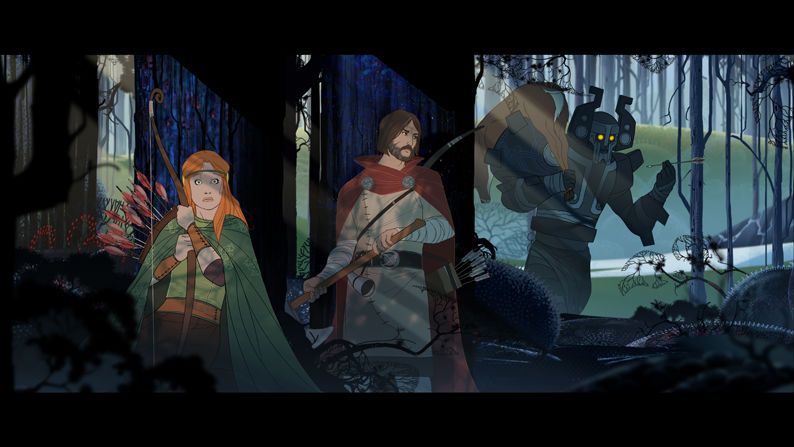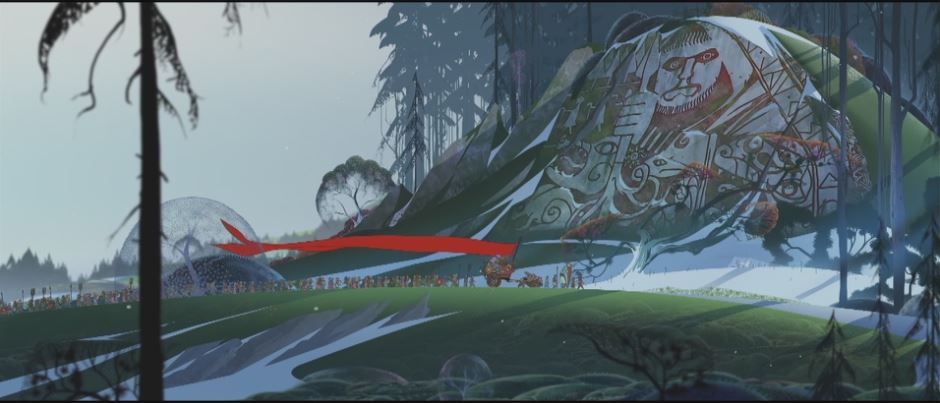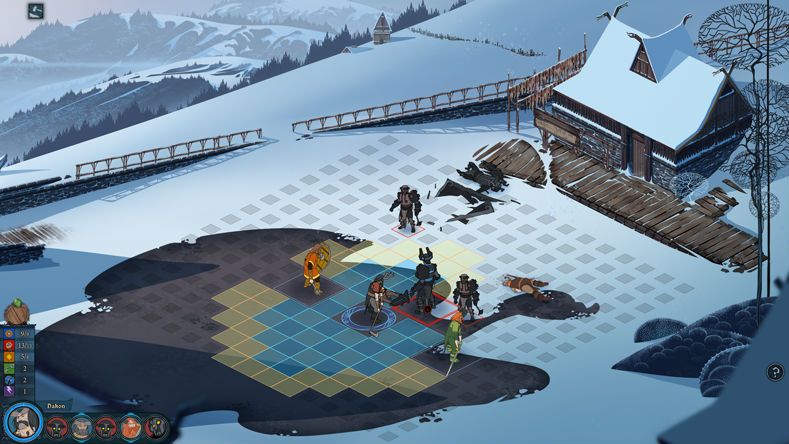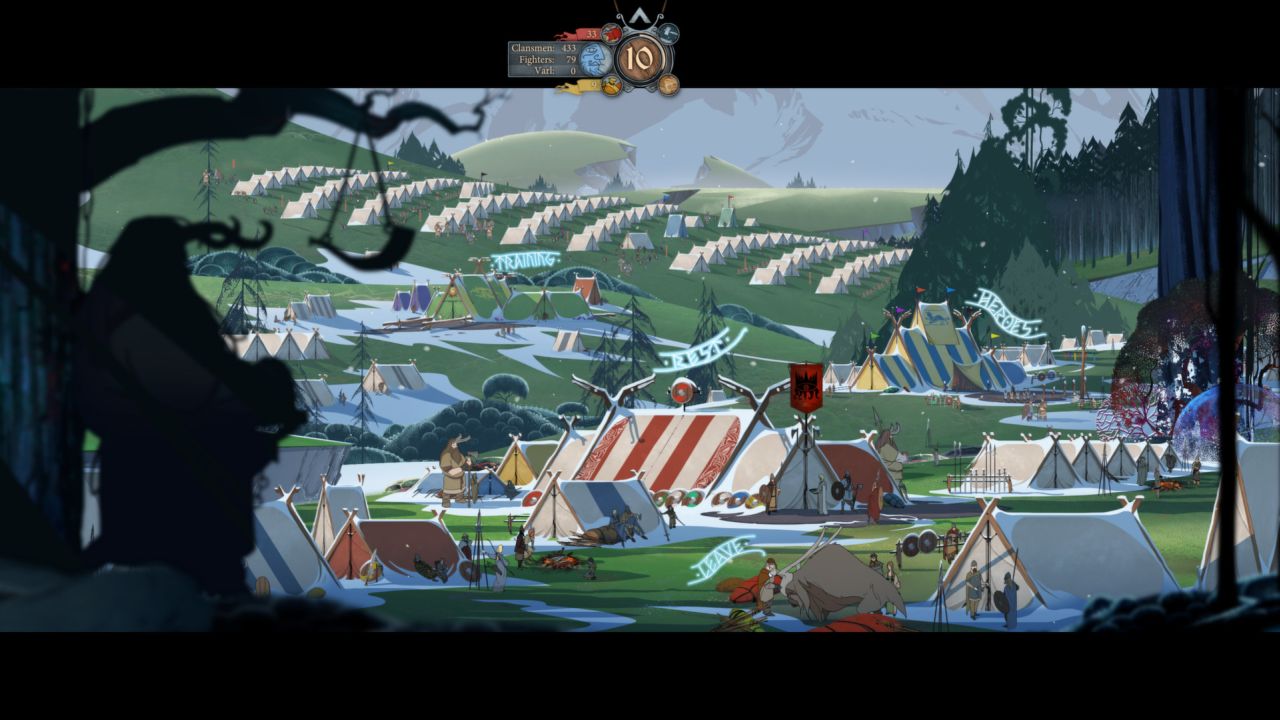The Banner Saga Review
The Banner Saga is a game that got its funding back when Kickstarter was still new and invigorating. Running a campaign nearly a month after Double Fine Adventure blew away its funding goal, the dream project of three industry veterans exceeded its own goal by 700% with over 20,000 contributors. Now the wait is finally over and The Banner Saga is a shimmering example of how three people at Stoic with a “can-do” attitude can create a product that steals your imagination, toys with your soul, and gives you an unforgettable experience. Despite its pesky flaws, The Banner Saga is a game that will make you thankful for Kickstarter.
The greatest praise for The Banner Saga is the way it can immerse you in its fantasy world. The games passes on the traditional elves and dwarves, trying to build a setting that is feels different from other sword and sorcery universes. The result is a brutal realm where you spend less time feeling empowered by mystical magics and more time cowering in fear of them. From snow capped mountains, to mead halls, to dark forests, the world of The Banner Saga feels as familiar as it does distinct. The most notable addition to the library of fantasy creatures is the giant, antler-bearing varl and the fearsome fleshless dredge. Soulless soldiers of steel and giants are far from the most creative things dreamt up for a fantasy world, but they fit the tone of The Banner Saga nicely, again adding a small variation on what is already familiar.

The story of The Banner Saga is surprisingly deep, lasting a solid 10-12 hours and telling a well-crafted tale of the invading dredge who must be stopped by an alliance of man and varl. Players will spend a good chunk of the game as a varl war party transporting a human prince to their capital as part of a tradition which signifies the alliance between the two races. During this journey the varl are attacked by the dredge who were thought to be vanquished. The second half of the story is told from the perspective of a human named Rook whose village is one of the first to fall to the dredge. After the death of his chieftain, Rook finds himself leading a caravan of refugees through a long and perilous journey to try and find safety for his people.
The varl half of the story is plenty interesting and produces most of the valuable exposition about the politics and history of the world, but it is Rook’s story that truly steals the spotlight. Rook’s party is filled with fascinating characters who have varying shades of grey to define their personality. Players are forced to make pivotal choices that affect the narrative and Stoic has written some amazing no-win scenarios for you to try and venture through. The characters that surround Rook paint the scene with their advice, which make these hard decisions even more difficult and add weight to each choice, despite the games overall linear structure]. The world of The Banner Saga may be absorbing, but the characters and story are what propel you forward, making it hard to pull yourself away.
While the story and world of The Banner Saga are fantastic, the game feels the weight of its shoestring budget and occasionally falters. The biggest of these issues is the technical prowess of the cutscenes and the way the game conveys its narrative. Often, the story of The Banner Saga is told through text pop-ups, occasionally breaking for motionless scenes where the characters dialogue is conveyed through more text. It is not an ineffective way to tell a story, however the game fails to ramp up its cutscenes for major plot-point moments. Moments of sacrifice, triumph, and defeat are all conveyed in the same static nature as the rest of the game, making them painfully indistinguishable. It is in these moments that the restricted budget of Stoic becomes clear, which is too bad because it is so forgettable most other times.

When you are not immersed in the story of The Banner Saga you will be confronted with the game’s challenging and unforgiving gameplay. Blending Oregon Trail’s journey-simulation with strategy RPG, the game does an effective job of giving players an unrelenting challenge as they desperately try to lead their people away from the dredge threat. Battles all take place on a grid, with turn-based, tactical combat. While the combat is not earth-shattering in its brilliance, it adds a nice twist as each enemy has an armor rating that must be reduced in order to do more damage to their actual life. This adds spice to the fray, as you will have to decide when to weaken an enemy’s armor and when to go for the kill. Enveloping the combat is standard RPG upgrading and item equipping. While this adds something to the gameplay, it is all pretty standard RPG fare. The game does not have perma-death, but when your allies fall they will be injured and fight at minus until they are given a couple days to heal. Some battles can be lost, altering the path of the story, but losing certain battles result in a “game over” screen.
In between battles you will find yourself on the road, your caravan trudging behind you. Here you will have to play the role of leader, purchasing supplies and managing morale. From internal struggles to external threats, players will have to decide who they will protect as more and more people begin to ask you for assistance. Playing the hero and villain lead to equal amounts of reward and punishment. Saving a village might grant you a powerful character to assist you in battle, whereas taking on a group of starving refugees can lead to betrayal and lost supplies. There is a constant tension and uneasiness that accompanies this portion of the game. On normal difficulty I found myself scraping by, running out of food a day or two before reaching my destinations, trying to save as many as I could and bleakly watching my party crumble as the elements and enemies did their damage. The challenge is poetic, it is visceral, and it helps complete the brutal world of blood and war that developers at Stoic have built.
There are shortcomings in the gameplay design of The Banner Saga, but unlike the narrative missteps, these wounds are not due to budgetary constraints. While the game can be extremely difficult on its normal setting it becomes almost too simple when toned down to easy. Battles go from brutal scenarios that you are almost certain you will lose, to a lazy walk in the park. A fine tuning of difficulty would have been nice to make sure everyone can get the right level of challenge. The larger problem is that, while The Banner Saga has a handful of tutorials and well-placed instructions, there are a certain moments where elements are poorly explained. One encounter really tripped me up as I missed a special power-up I had to use, another time I didn’t have the right item equipped. The Banner Saga is plenty challenging without occasionally stumbling over vague instructions.
There are other small issues with the game that take away from the experience. Most of this is related to the UI and options menu. The Banner Saga is sorely lacking in simple options such as subtitles, volume controls, and graphical settings. Much like the narrative issues, it is clear to see that these are things that had to be scrapped given the size of the project, but even with its $700,000 budget The Banner Saga deserves to be compared to the best games and lacking these options does stand out.

For all of these small complaints, there are small things to love about The Banner Saga. The art of game is absolutely gorgeous, capturing epic landscapes and intricate character details with equal precision and skill. Each location and person you talk to is completely unique, helping add to the epic scope of The Banner Saga’s vision. Seeing the dredge slowly crowd in around your resting screen as you prepare for large scale battles adds tension to each passing moment, demonstrating the desperateness of your situation. Topping all of these little bonuses off, is Austin Wintory’s absolutely astounding score. Combining strong horn themes with plucky strings, Wintory captures themes that build the grandeur of the adventure and creates suspense. The score also features vocal soloists that sing ballads as you approach certain markers on the ma;, these songs add to the Viking-fantasy flavor that Stoic worked so hard to create. There are a lot of things to love when it comes to the big picture of The Banner Saga, but there a plenty of finely crafted details that are equally great.
The biggest issue, bar none, is the game’s instability. During my playthrough I experienced a handful of crashes and since the only way to save your game is through autosaves you never know where the game is going to leave you when you boot back up. There is a pretty generous autosave function and I never was pushed back to the point of frustration, but it is still plenty annoying. The timing of these crashes is particularly troublesome as they always seemed to occur during major plot points, derailing the momentum of my playthrough, betraying the excellent pacing and structure of the game.

The Banner Saga has its shortcomings, most of them the result of a small budget and a smaller team. There are missing features, and at times the production fails to support the writing and gameplay. But on the whole the game is a triumph. The story feels finely tuned, and the gameplay feeds back into the brutal, visceral, wintery world in which the game is set. All elements of the game make you feel like your time at the head of your clan is filled with hurdles and impossible odds, but it is these overwhelming odds that lead to a feeling of reward. The game makes you feel like you are always on your heels, always one step away from failure, but keeps you going even you think you can’t. The Banner Saga is a game that roots itself under your skin, and will have you thinking about it long after its poetic and emotional conclusion.
